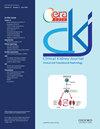Post-transplant renal anaemia: a call to action from a national study in routine clinical practice
IF 3.9
2区 医学
Q1 UROLOGY & NEPHROLOGY
引用次数: 0
Abstract
Background Post-transplant anaemia is a prevalent yet often overlooked condition that poses significant risks. Current guidelines consider the same treatment recommendations and goals for these patients as for chronic kidney disease patients not on dialysis (CKD-NDD). Previous old reports demonstrated lack of awareness and suboptimal management indicating a pressing need for improvement. We therefore wanted to update this information on post-transplant anemia. Aims To describe the present state of anaemia management, goals, and adherence to guidelines within a representative sample of the kidney transplant (KTx) population. Methods We designed a retrospective nationwide multicentre study including outpatients from 8 KTx hospitals. Nephrologists gathered data from electronic medical records encompassing demographics, comorbidities, KTx characteristics and immunosuppressive therapy and information pertaining to anaemia management (laboratory values, previously prescribed treatments, and subsequent adjustments). The European statement on KDIGO guidelines was the reference for definitions, drug prescriptions and targets. Anemia occurring within the initial six months post-transplantation was classified as early onset. Results We included 297 patients with post-transplant anemia aged 62.8 (SD 13.6) and 60% male. They had received a graft from cardiac-death or brain-death donors (61.6% and 31.1%, respectively) a median of 2.5 years [0.5–8.7] before. Among them 77% (n = 228) were classified as having late post-transplant anemia, characterized by a higher prevalence of microcytic and iron deficiency anemia. A total of 158 patients were on erythropoietic stimulating agents (ESAs) treatment, yet surprising 110 of them lacked iron supplementation. Notably, 44 patients had an indication for iron supplementation and among them, 30 exhibited absolute iron deficiency. Out of the 158 patients receiving ESAs, only 39 surpassed the limit for the ESA resistance index indicating poor response. This resistance was more frequent among patients with early post-transplant anemia (26.1 vs 9.2%). We have identified iron profile, early post-transplant anemia and eGFR as factors associated with the highest risk of resistance Conclusion We found that Hb targets are individualized upwards in post-transplant anemia. In this setting, iron therapy continues to be underutilized, especially intravenous, and iron deficiency and prior events (blood transfusion or hospital admission) explain most of the hyporesponsiveness to ESA. This highlights missed opportunities for precise prescription targeting and adherence to established guidelines, suggesting a need for improved management strategies in post-transplant anemia patients.移植后肾性贫血:一项全国性研究呼吁在常规临床实践中采取行动
背景移植后贫血是一种普遍存在但又经常被忽视的疾病,具有很大的风险。目前的指南认为这些患者的治疗建议和目标与非透析慢性肾病患者(CKD-NDD)相同。以前的旧报告显示,人们对该病缺乏认识,管理不善,这表明该病亟待改善。因此,我们希望更新有关移植后贫血的信息。目的 描述肾移植(KTx)人群中具有代表性样本的贫血管理现状、目标以及对指南的遵守情况。方法 我们设计了一项全国多中心回顾性研究,研究对象包括 8 家肾移植医院的门诊患者。肾病专家从电子病历中收集数据,包括人口统计学、合并症、KTx 特征、免疫抑制治疗以及与贫血管理相关的信息(实验室值、之前的处方治疗和后续调整)。定义、药物处方和目标均以欧洲 KDIGO 指南声明为参考。移植后最初六个月内发生的贫血被归类为早发性贫血。结果 我们纳入了 297 名移植后贫血患者,他们的年龄为 62.8 岁(SD 13.6),60% 为男性。他们接受心脏死亡或脑死亡供体(分别占 61.6% 和 31.1%)移植的时间中位数为 2.5 年 [0.5-8.7]。其中 77% 的患者(228 人)被归类为移植后晚期贫血,其特点是小细胞性贫血和缺铁性贫血的发病率较高。共有 158 名患者正在接受促红细胞生成素(ESAs)治疗,但其中竟然有 110 名患者没有补充铁剂。值得注意的是,44 名患者有补铁指征,其中 30 人表现出绝对缺铁。在接受 ESAs 治疗的 158 名患者中,只有 39 名患者的 ESA 抗药性指数超过了极限,这表明他们的反应不佳。这种耐药性在移植后早期贫血患者中更为常见(26.1% 对 9.2%)。结论 我们发现,移植后贫血患者的血红蛋白目标个体化程度较高。在这种情况下,铁剂治疗仍未得到充分利用,尤其是静脉注射,而缺铁和既往事件(输血或入院)是ESA低反应的主要原因。这突出表明,在精确确定处方目标和遵守既定指南方面错失了良机,因此需要改进移植后贫血患者的管理策略。
本文章由计算机程序翻译,如有差异,请以英文原文为准。
求助全文
约1分钟内获得全文
求助全文
来源期刊

Clinical Kidney Journal
Medicine-Transplantation
CiteScore
6.70
自引率
10.90%
发文量
242
审稿时长
8 weeks
期刊介绍:
About the Journal
Clinical Kidney Journal: Clinical and Translational Nephrology (ckj), an official journal of the ERA-EDTA (European Renal Association-European Dialysis and Transplant Association), is a fully open access, online only journal publishing bimonthly. The journal is an essential educational and training resource integrating clinical, translational and educational research into clinical practice. ckj aims to contribute to a translational research culture among nephrologists and kidney pathologists that helps close the gap between basic researchers and practicing clinicians and promote sorely needed innovation in the Nephrology field. All research articles in this journal have undergone peer review.
 求助内容:
求助内容: 应助结果提醒方式:
应助结果提醒方式:


